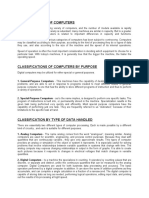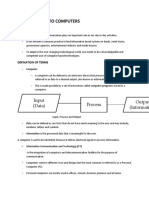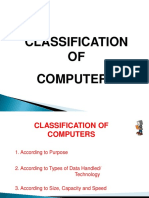Classification of Computer
Uploaded by
n29604741Classification of Computer
Uploaded by
n29604741CLASSIFICATION OF COMPUTER
(Chapter-8) Classification of Computer:-
The computer systems can be classified on the following basis:
o On the basis of size.
o On the basis of purpose.
o On the basis of data handling or functionality
On the Basis of data handling computer divided into 3 different types.
o Analog Computer
o Digital Computer
o Hybrid Computer
Analog : An analog computer is a form of computer that uses the continuously-changeable
aspects of physical fact such as electrical, mechanical, or hydraulic quantities to model the
problem being solved. Any thing that is variable with respect to time and continuous can be
claimed as analog just like an analog clock measures time by means of the distance travelled for
the spokes of the clock around the circular dial.
Digital : A computer that performs calculations and logical operations with quantities
represented as digits, usually in the binary number system of “0” and “1”, “Computer capable of
solving problems by processing information expressed in discrete form. from manipulation of the
combinations of the binary digits, it can perform mathematical calculations, organize and analyze
data, control industrial and other processes, and simulate dynamic systems such as global
weather patterns.
Hybrid : A computer that processes both analog and digital data, Hybrid computer is a digital
computer that accepts analog signals, converts them to digital and processes them in digital form.
Classification on the basis of size
o Super Computer
o Mainframe Computer
o Mini Computer
o Micro Computer
Super Computers: The super computers are the most high performing system. A
supercomputer is a computer with a high level of performance compared to a general-purpose
computer. The actual Performance of a supercomputer is measured in FLOPS instead of MIPS. All
of the world’s fastest 500 supercomputers run Linux-based operating systems. Additional research
is being conducted in China, the US, the EU, Taiwan and Japan to build even faster, more high
performing and more technologically superior supercomputers. Supercomputers actually play an
important role in the field of computation, and are used for intensive computation tasks in various
fields, including quantum mechanics, weather forecasting, climate research, oil and gas
exploration, molecular modeling, and physical simulations. and also Throughout the history,
supercomputers have been essential in the field of the cryptanalysis.
eg: PARAM,
Mainframe computers : These are commonly called as big iron, they are usually used by big
organisations for bulk data processing such as statics, census data processing, transaction
processing and are widely used as the servers as these systems has a higher processing capability
as compared to the other classes of computers, most of these mainframe architectures were
established in 1960s, the research and development worked continuously over the years and the
mainframes of today are far more better than the earlier ones, in size, capacity and efficiency.
Eg: IBM z Series, System z9 and System z10 servers.
Plot-1441, Opp. IOCL Petrol Pump, CRP Square, Bhubaneswar-751015
Ph. :8093556677, 9040456677, Web :, E-mail : vanikbbsr@gmail.com 1
CLASSIFICATION OF COMPUTER
Mini computers : These computers came into the market in mid 1960s and were sold at a
much cheaper price than the main frames, they were actually designed for control,
instrumentation, human interaction, and communication switching as distinct from calculation
and record keeping, later they became very popular for personal uses with evolution.
In the 60s to describe the smaller computers that became possible with the use of transistors and
core memory technologies, minimal instructions sets and less expensive peripherals such as the
ubiquitous Teletype Model 33 ASR. They usually took up one or a few inch rack cabinets,
compared with the large mainframes that could fill a room, there was a new term
“MINICOMPUTERS” coined
Eg: ATM, ticket book, wait machine
Micro computers : A microcomputer is a small, relatively inexpensive computer with a
microprocessor as its CPU. It includes a microprocessor, memory, and minimal I/O circuitry
mounted on a single printed circuit board. The previous to these computers, mainframes and
minicomputers, were comparatively much larger, hard to maintain and more expensive. They
actually formed the foundation for present day microcomputers and smart gadgets that we use in
day to day life.
Eg: Personal Laptop, PC etc,Tablets, Smart-watches.
Computer classified into two types based on purpose
o General Purpose
o Special Purpose
General Purpose Computers:- General-purpose computers are designed to solve a large
variety of problems. That is they can be given different programmes to solve different types of
problems. General-purpose computers can process business data as readily as they process
complex mathematical formulas. General-purpose computers can store large amount of data and
the programmes necessary to process them. Because general-purpose computers are so versatile,
most businesses today use them. Most digital computers are general computers and it is mainly
such computers that are used in business and commercial data processing.
Special Purpose Computers:- Special purpose computers are designed to solve a specific
problems; the computer programme for solving the problem is built right into the computer.
Special purpose computers have many features of general-purpose computers but are designed to
handle specific problems and are not applied to other computerized activities. For example,
special purpose computers may be designed to process only numeric data or to completely
control automated manufacturing processes. Moat analogue computers are special purpose
computers.
Special purpose computers are often used as training simulators. A simulator is a computer-
controlled device for training people under simulated, or artificially created, conditions. The
computer creates test conditions the trainee must respond t. it then records and evaluates he
responses, providing these results to both trainee and supervisor.
Plot-1441, Opp. IOCL Petrol Pump, CRP Square, Bhubaneswar-751015
Ph. :8093556677, 9040456677, Web :, E-mail : vanikbbsr@gmail.com 2
You might also like
- Vienna Simulators LTE-A Downlink System Level Simulator Documentation, v1.8r1375No ratings yetVienna Simulators LTE-A Downlink System Level Simulator Documentation, v1.8r137534 pages
- Evolution and Classification of ComputersNo ratings yetEvolution and Classification of Computers37 pages
- Classification of Computers: Arisha Fatima DPT 01, MihsNo ratings yetClassification of Computers: Arisha Fatima DPT 01, Mihs12 pages
- Unit_II_Types of Computer_d55199a19e39b871054d7c2497501599No ratings yetUnit_II_Types of Computer_d55199a19e39b871054d7c24975015997 pages
- UNIT-9 PRAYASKSG ,ICT PRE + MAINS COMBINEDNo ratings yetUNIT-9 PRAYASKSG ,ICT PRE + MAINS COMBINED140 pages
- Introduction & History of Computers, Their Applications: Sarhad University of Science & Information Technology PeshawarNo ratings yetIntroduction & History of Computers, Their Applications: Sarhad University of Science & Information Technology Peshawar26 pages
- Types of Computers Based On Principles of OperationNo ratings yetTypes of Computers Based On Principles of Operation6 pages
- Analog Computers: The Analog Computer Is Almost An Extinct Type of Computer TheseNo ratings yetAnalog Computers: The Analog Computer Is Almost An Extinct Type of Computer These4 pages
- Computer Skills Introduction To Computers: Dr. Hassan Yossry & DR Mahmoud Al NahasNo ratings yetComputer Skills Introduction To Computers: Dr. Hassan Yossry & DR Mahmoud Al Nahas22 pages
- What Is Simplex Transmission Mode?: Computer NetworkingNo ratings yetWhat Is Simplex Transmission Mode?: Computer Networking2 pages
- Rebalancing Shared Mobility-On-Demand Systems: A Reinforcement Learning ApproachNo ratings yetRebalancing Shared Mobility-On-Demand Systems: A Reinforcement Learning Approach7 pages
- Advantages and Disadvantages of Information SystemsNo ratings yetAdvantages and Disadvantages of Information Systems42 pages
- SIPROTEC 4 7UT6 Differential Protection Relay For Transformers, Generators, Motors and BusbarsNo ratings yetSIPROTEC 4 7UT6 Differential Protection Relay For Transformers, Generators, Motors and Busbars9 pages
- Inviting Colleagues: English For Accounting (Page 29-38) Farida Indri Wijayanti, M.PDNo ratings yetInviting Colleagues: English For Accounting (Page 29-38) Farida Indri Wijayanti, M.PD17 pages
- CWMP - Protocol - For - The - Print - Industry - Aht Ver3No ratings yetCWMP - Protocol - For - The - Print - Industry - Aht Ver323 pages
- How I Found An XSS Vulnerability Via Using Emojis by Patrik Fabian Aug, 2022 MediumNo ratings yetHow I Found An XSS Vulnerability Via Using Emojis by Patrik Fabian Aug, 2022 Medium3 pages
- Press Release: Infinix Releases Stunning New NOTE 12 5G Series With Next-Level Photographic CapabilitiesNo ratings yetPress Release: Infinix Releases Stunning New NOTE 12 5G Series With Next-Level Photographic Capabilities5 pages
- Mantra MFS100 RD Service Manual Windows 1.1.0No ratings yetMantra MFS100 RD Service Manual Windows 1.1.016 pages
- Fundamentals of Computer Networks ECE 478/578No ratings yetFundamentals of Computer Networks ECE 478/57837 pages

























































































